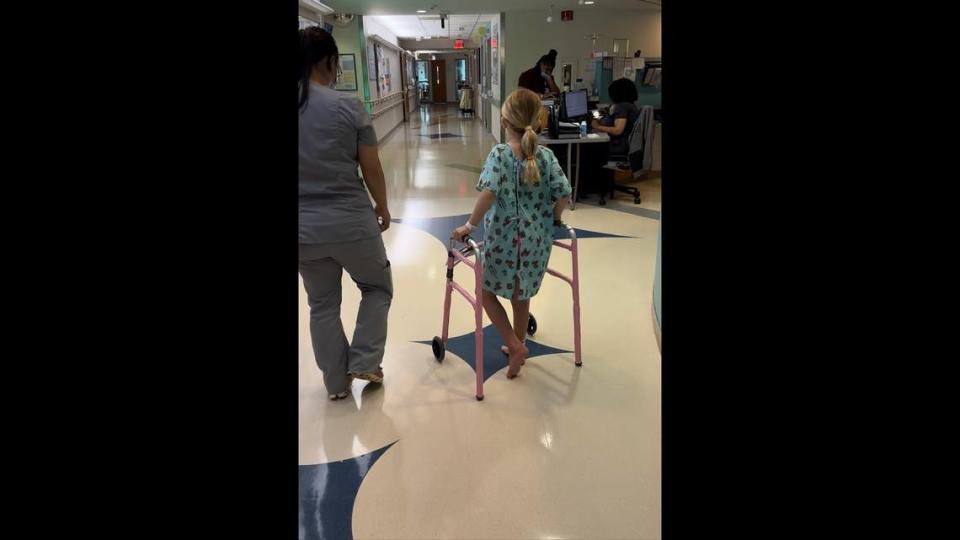‘This is what can happen.’ NC girl learns to walk again after invasive strep case
Emma never had a sore throat. No hoarse voice, no white sores, no signs of sickness.
She was a “freakishly healthy kid,” her mother said. The 7-year-old Charlotte girl hardly caught a cold since she was 2.
Then a fluke strep infection attacked Emma’s hip in May. It landed her in the hospital for more than a week and kept her using a wheelchair — then a walker — for 21 days, according to Emma’s mother, Janna.

For days, Emma described her pain as a 20 on a scale of 1-10. She fought a 103 degree fever for days and a 101 fever for more than a week. She clutched onto her stuffed animal, Teddy, through each MRI scan, wheelchair ride and blood test at Levine Children’s Hospital.
She screamed so loud her father’s Apple Watch told him he needed to move — that he was risking hearing loss by staying near his daughter. Her 113 decibel wails were comparable to being three feet away from a roaring chainsaw or 100 feet away from a jet taking off.
But doctors said Emma’s case was mild, according to Janna. She was confused, she said, and offended.
Now she understands.
It could’ve been much worse.
Invasive strep in kids
While a strep infection hospitalized Emma it also killed another child in Mecklenburg County, according to North Carolina’s Department of Health and Human Services.
Group A strep (GAS) bacteria had infected both Emma and the other child, whose age was not released by health officials.
Emma’s mom said her daughter doesn’t know exactly what happened to her, and she’s not sure when they’ll be able to explain it. She agreed to be interviewed on the condition the family’s last name would not be published.
Both mother and daughter are traumatized, Janna said.
“She knows that she had bad stuff in her body and that she took all this medicine to get the bad stuff out,” Janna said, “but she definitely does not know that she had a life-threatening infection.”
The bacteria, which is present in most standard strep throat infections, can also latch onto bodies when it lands on skin or sores, doctors say.
The infections turn invasive and dangerous when bacteria reach tissue, bloodstreams or spinal fluid, according to Dr. Amina Ahmed, chief of pediatric infectious diseases and immunology at Levine Children’s Hospital.
While adults experience the majority of invasive infections, children’s cases have been on the rise.
The child’s death in May was the first pediatric death due to an invasive group A strep infection in Mecklenburg County this year, county data shows.
Once infected, there’s no consistent time frame for when — or if — infections turn deadly, Ahmed said.
“Once it’s in your throat, it’s unfortunately just a matter of bad luck how it gets into your bloodstream or if it gets into your bloodstream,” she said.
Identifying strep infections
Emma’s family isn’t exactly sure when or where she was exposed to strep, though her best friend tested positive for strep the Thursday before Emma’s hospitalization. By that Sunday, Emma’s leg pain kept her from moving at all. She couldn’t even get up to use the bathroom.
Atrium Health’s Providence Emergency Room near Waverly couldn’t offer any answers after taking Emma’s X-rays and CT scans, according to Janna. The doctors initially thought she may have broken a bone, pulled a muscle or been experiencing growing pains.
Answers didn’t come until doctors at Levine tested Emma’s blood and three days later sent her through an MRI scanner when one became available. The strep infection had spread through all her tissues and leg muscles, Janna said.
“Strep was the last thing on my mind,” she said. “I didn’t even think that was possible.”
Janna was glad Levine’s doctors were able to catch and treat the infection when they did, but she keeps thinking about what would have happened if she didn’t take Emma into another hospital. Without bloodwork and MRI scans, doctors wouldn’t have known they were dealing with a strep infection, she said.
Rising strep cases in North Carolina
Invasive strep infections are rare, Ahmed said. But they’re leading to increased adult and children hospitalizations that are perplexing doctors across the country, according to state and U.S. data.
While infections dropped significantly when people quarantined and masked, recent spikes surpass even pre-pandemic numbers, data shows. Officials don’t know why cases are spiking again, Ahmed said. Some infections are preceded by chicken pox, COVID or the flu, Ahmed said.
Ahmed said each month she sees 10 to 15 pediatric strep patients at Levine. While some cases aren’t considered invasive infections, the symptoms are severe enough for hospitalization.
Infections become most problematic and potentially fatal when the patient develops streptococcal toxic shock syndrome, Ahmed said.
For nearly half of people suffering from the toxic shock syndrome, according to the CDC, doctors do not know how the bacteria got into the body. Once in deep tissues or bloodstreams, bacteria causes low blood pressure, rapid breathing and increased heart rate, the CDC said.
There have been a total of 33 invasive group A strep infections in Mecklenburg County so far this year, including five pediatric cases. Two adults also died with infections this year locally, county data indicates. Last year, there were 43 total cases in Mecklenburg County, and in 2021 there were 24.
Cases typically spike from October to April, Ahmed said, but the recent strep season was particularly bad.
Statewide, between 2016 and 2022 an average of 15 invasive pediatric group A cases were logged annually between October and April, according to state data.
But since October 2022, North Carolina has seen 62 pediatric infections, state data indicates. Mecklenburg County has had the most cases among children.
North Carolina has seen most of its cases among adults. Statewide, there have been 468 invasive group A cases in 2023 — compared to 461 for all of last year, health records show.
With 47 deaths in 2023 so far, the state has had more fatalities from invasive strep this year than any year going back to 2016.
Taking precautions against strep infections
According to Mecklenburg County’s Public Health Department, there aren’t any specific guidelines in place for identifying potential strep cases at schools or day cares. If cases are detected, the department contacts the school nurse or daycare administrator to identify other cases and notify at-risk families.
Adrianne Hobbs, senior vice president of youth development for the YMCA of Greater Charlotte, said the pandemic taught leaders many lessons about health protocols and how to best keep kids safe.
“Our staff remain vigilant in cleaning procedures, frequent handwashing, spending time outside in fresh air, and monitoring symptoms of our campers to detect illness,” she said.
Dwindling antibiotics supply
Janna didn’t realize how bad Emma’s infection was until she Googled the antibiotic doctors put in her IV. Cefazolin, which coursed through Emma’s veins, was used for serious bacterial infections.
Emma also went through one wash out procedure that cleared the infection from her hip joint, Janna said. She was in even more pain when she came out of it, but it worked. Emma eventually left the hospital when she was able to use a walker by herself.
Pediatric amoxicillin, which comes in liquid form so it’s easier for children to take, is normally prescribed to children with strep infections, Ahmed said. It was added to the Food and Drug Administration’s list of drug shortages in October, NPR reported.
While amoxicilin and penicillin are the drugs of choice for treating strep, doctors have substitute medications in their back pocket, Ahmed said. Infections can still be treated, she said, they just may require higher doses.
One step at a time
Emma doesn’t have any siblings, but her classmates came to visit her throughout her hospital stay. When she was out of the hospital, but still in a wheelchair, she visited her private Charlotte school and read a book to her class before students were released for the summer.
Every day is a struggle, Janna said. Emma started walking without a walker 21 days after her initial hospital visit, but she struggles to envision herself as more than a 7-year-old with a limp.

Once yearbooks were released, Emma and her mom looked through the photos.
“That could be you one day,” Janna said, pointing to the middle school cheerleading team.
“No,” Emma said. “That won’t be me. I won’t be able to walk.”
It’s heartbreaking, Janna said.
“She thinks she’ll never be able to walk normal, that she’ll never be able to do cartwheels,” she said.
Janna signed Emma up for summer cheerleading and swim camps before her hospitalization and hopes they will help Emma move past May’s trauma.
Each flu season or strep-scare will no doubt put Janna on edge for the rest of Emma’s life, she said. She doesn’t want Emma to be scared of sickness for the rest of her life, but she also wants people to know how bad infections can get seemingly out of nowhere.
“I don’t want to create fear,” she said, “but if your child has strep and it goes untreated this is what can happen.”

